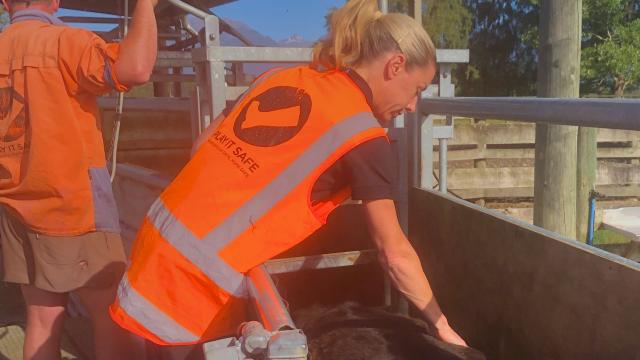Training workshops giving beef breeders the tools to measure beef cow body condition and assign teat size and udder suspension scores are a step towards the development of New Zealand-specific Estimated Breeding Values.

The workshops, which are part of the seven-year Informing New Zealand Beef programme (INZB), were run in the North and South Island by B+LNZ Genetics Beef Specialist Anna Boyd and Genetics Specialist Jason Archer.
Anna says they focused on breeders as the programme needed performance-recorded data in the development of NZ-specific Estimated Breeding Values (EBVs).
She says Body Condition Score (BCS) and Teat and Udder scores were traits identified as being important to beef farmers through the industry-wide Trait Prioritisation Survey carried out in the early stages of the programme.
Anna says structure came out as a priority for commercial beef farmers and BCS and Teat and Udder traits sat within that.
“We considered these to be low hanging fruit as they are easy to record and inexpensive to measure on farm. They are also moderately heritable.”
She says teat and udders, in particular, are two of the most functional traits as they have a direct impact on beef cow productivity.
Poor teat size and udder suspension can result in an increased chance of injury, increased risk of mastitis and decreased calf growth rates.
While many of the breeders that attended the workshops were already recording teat and udder scores they had not necessarily been recording consistently or at the right time.
“It needs to be done either at calving or within 24 hours of calving,” says Anna.
B+LNZ Genetics is encouraging all breeders to use the same teat and udder scoring scale which is one developed by the US-based Beef Improvement Federation (BIF).
This scale has been adopted by breed associations around the world.
The workshops also included a practical component on Body Condition Scoring to encourage farmers to move away from using Rib and Rump Fat EBVs as an indication of body condition.
“We know from our B+LNZ Beef Progeny Test data which includes thousands of cow Body Condition Scores alongside ultrasound muscle measurements on young animals, that rib and rump fat measurements are a crude tool for predicting body condition, with only a 25 percent correlation,” says Anna.
Instead, they would like farmers to use the NZ-developed BCS scale of one to 10, which is also used by the NZ dairy industry.
“We are encouraging consistency although we know it’s not always easy, it requires experience and confidence.”
At the workshop, Anna demonstrated to breeders what parts of the cow to look at to score body condition, encouraging them to get along the race and put their hands on the cows to access their condition.
Having consistent BCS measurements will help in the development of an EBV for that trait.
She says weaning is the ideal time to BCS breeding cows, as the data is ideally collected alongside mature cow weight.
Anna says breeders attending the workshops represented eight different beef breeds.
Many already have a wealth of historical data which could also be used in the development of the trait EBVs.
Performance Beef Breeders will collect data from breeders, and this will be used within the INZB programme to help develop the EBVs.
The seven-year Informing New Zealand Beef (INZB) programme is a partnership between Beef + Lamb New Zealand, the Ministry for Primary Industries and the New Zealand Meat Board. It aims to boost the sector’s profits by $460m over the next 25 years.
Focused on increasing uptake of the use of high-quality genetics in the beef industry, the four main components of the programme are developing New Zealand-specific breeding indexes, building a genetic evaluation and data infrastructure, running progeny test herds and developing new data sources.
You can watch the Beef Cow Body Condition Scoring training video on the Knowledge Hub.